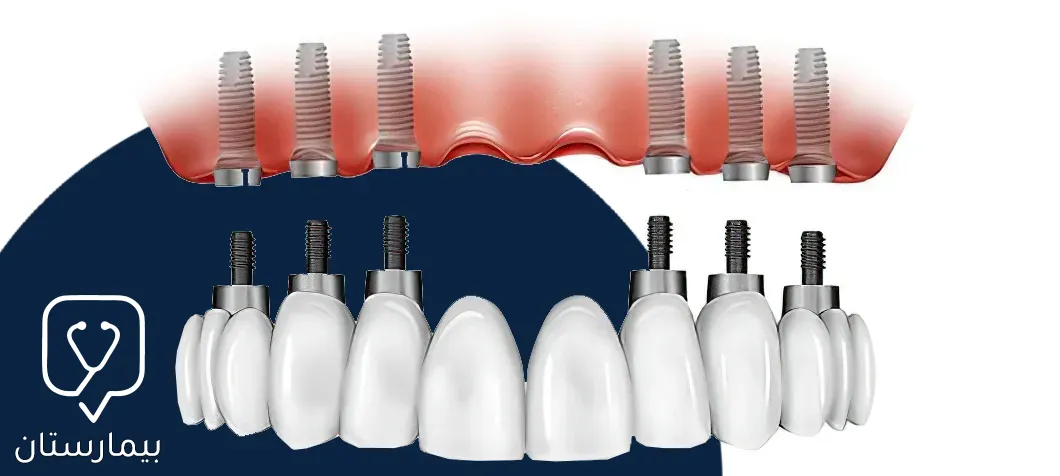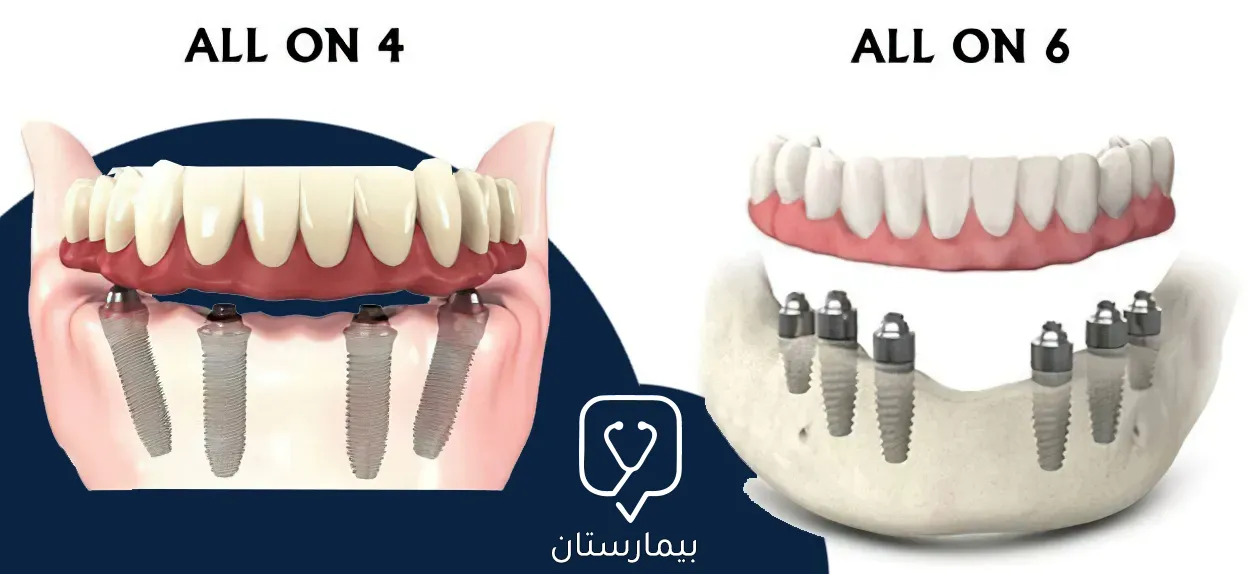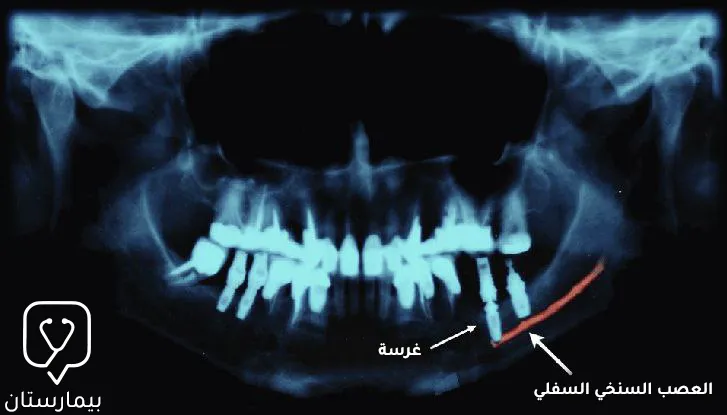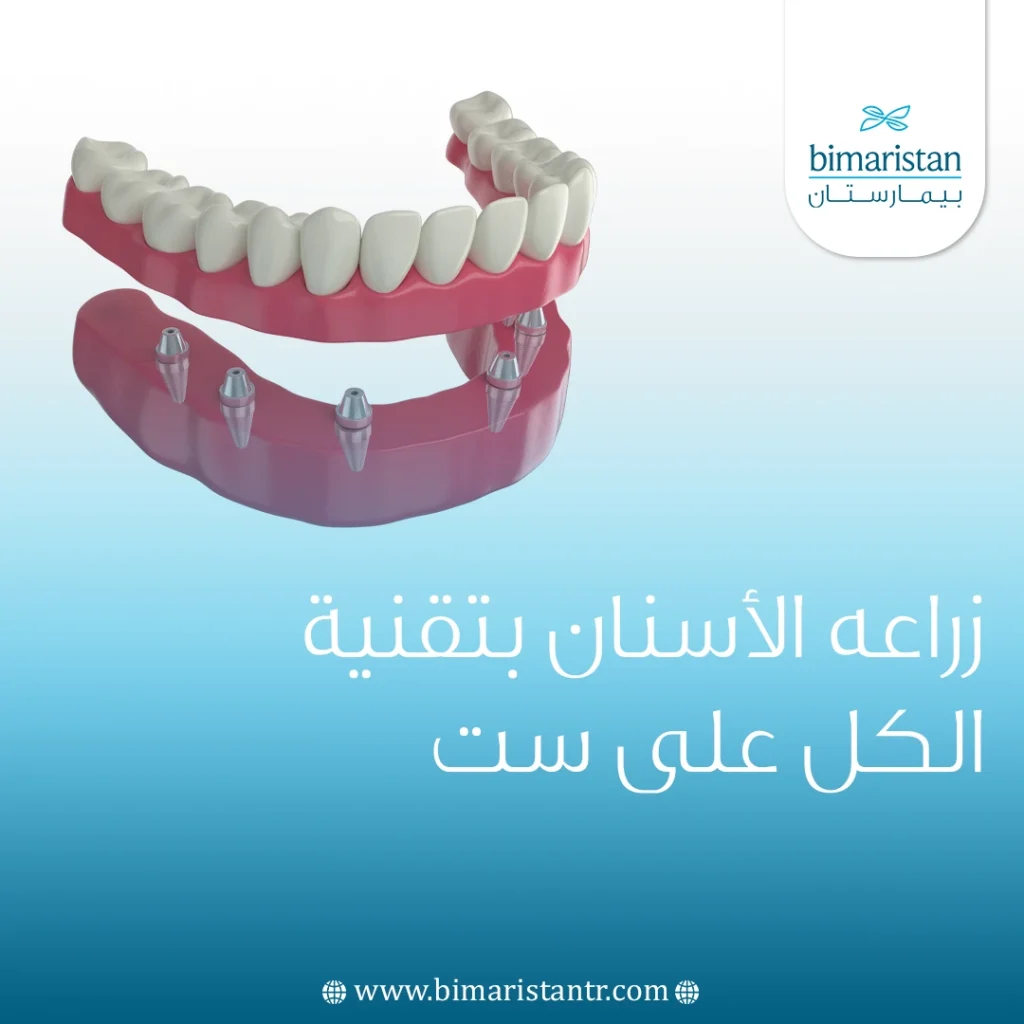الزرعات السنية بتقنية all on 6 تعد من أحدث تقنيات العلاج في تركيا وأفضلها إن كنت تعاني من فقد كبير أو كلي بالأسنان، تابع معنا لتتعرف عن هذه التقنية بشكل أكبر.
يعتمد طب الأسنان اليوم على مواكبة أحدث التقنيات لعلاج فقد الأسنان، وليقدم للمريض حلاً يعيد له ابتسامته ومظهر الأسنان الطبيعية، سواء أكان الفقد سناً مفرداً يوضع مكانه زرعة واحدة single implant أو مجموعة أسنان multiple implants يمكن الاستعاضة عنها بعدة غرسات، ويمكن القول أن الزرعات السنية بتقنية all on 6 من تقنيات المعالجة الأمثل لتكون بديل عن الأسنان التالفة أو المفقودة.
لابد أن لديك بعض التساؤلات حول هذه العملية هل هي مؤلمة؟ ما هي المدة المستغرقة لزراعة الاسنان؟ هل هناك مخاطر لهذه التقنية؟ وفي موقع بيمارستان الطبي في تركيا سنجيبك عن كل تلك الأسئلة.
ما هي الزرعات السنية بتقنية all on 6؟
الزرعات السنية بتقنية all on 6 هي بشكل أساسي إحدى تقنيات زراعة للأسنان التي تتضمن التعويض عن كل الأسنان المفقودة باستخدام 6 زرعات سنية dental implants فقط، وذلك لتعيد الشكل التجميلي والحالة الوظيفية للفكين عبر عدة مراحل.
أثبتت الزرعات عموماً نجاحها لدعم التعويض السني التقليدي مثل الجهاز المتحرك الكامل وتحويله لخيار علاجي يصلح لمعظم الحالات وقد حققت نسب نجاح عالية في تركيا.
بداية يقوم الطبيب بفحص حالة الفم والأسنان ثم تجرى صور شعاعية يتم من خلالها تقييم حالة عظام الفكين والأبعاد اللازمة لوضع الزرعات السنية بمكان وبزاوية صحيحين، وهذه المرحلة تعد أحد أهم خطوات العلاج، بعدها تتم زراعة الأسنان على مرحلتين:
- وضع الزّرعات السنية
- وضع الأسنان الاصطناعية فوق الغرسات وتثبيتها بواسطة برغي صغير يوضع داخل الزّرعات السنية
وفي حال رغبة المريض بعدم البقاء دون أسنان إلى حين انتهاء صنع التعويض الدائم فوق الغرساتْ، تمكننا هذه التقنية من وضع تعويض مؤقت نفس يوم العملية الجراحية ويستطيع المريض عندها الخروج من المركز دون الشعور بالقلق حيال المظهر.
ومن الجدير بالذكر أن زراعة الأسنان يمكن أن تتم بالتخدير الموضعي كأي إجراء سني، أو اذا كنت من المرضى الذين يهابون العمليات بشدة فيمكن إجراؤها تحت التخدير العام.

ميزات الزرعات السنية بتقنية all on 6
عند الحديث عن هذه التقنية لا بد لنا أن نذكر أهم الميزات التي تجعل منها خياراً علاجياً مناسباً لمعظم حالات الفقد الكلي للأسنان فهي:
- تُوفِّر للمريض إعادة المظهر التجميلي عن طريق وضع اسنان مماثلة للطبيعية مما يعيد للمريض ثقته بنفسه وبابتسامته.
- تعيد القدرة على مضغ الأطعمة بشكل طبيعي.
- ليس من الضروري استخدام أجهزة متحركة كاملة (والتي تعد من التعويضات التقليدية التي تسبب الإزعاج لبعض المرضى)؛ حيث يتم استخدام جسر يثبت على الزرعات بواسطة براغي صغيرة وهذا يعطي أفضلية للنسج الداعمة التي كانت تتعرض للإجهاد بالتعويض المتحرك المستند عليها سابقاً.
- يمكن استخدامها في الحالات التي يكون فيها حجم الفك صغير، أو ذات كثافة عظمية منخفضة low bone density وبالتالي لا نحتاج إلى استخدام الطعوم العظمية غالباً.
- وقت التعافي قصير، أي المريض لا يحتاج أن يبقى دون أسنان لفترة طويلة حيث يمكن تركيب الاسنان أو التعويض بعد فترة قصيرة من العمل أو نستخدم تعويضاً مؤقتاً بنفس يوم عملية الزرع.
الفرق بين تقنية all on 6 وall on 4
الفرق الأكبر بين تقنية all on 4 وتقنية all on 6 هو بعدد الزَرعات السنية كما هو واضح، ولكن هذا الفرق له تأثير هام على التعويض حيث أن وجود غرستان إضافيتان يعني توزيع أفضل لقوى المضغ والقوى المطبقة على أسنان التعويض ودعم أفضل له وبالتالي ثبات أفضل، لكن الزرعات الإضافية تعني أيضاً تكلفة إضافية.

تعليمات بعد زراعة الأسنان في تركيا
من المهم لنجاح العمل الجراحي الالتزام ببعض التعليمات التي يعطيها الطبيب للمريض والتي تساعد على سرعة الشفاء ونجاح العمل ومن هذه التعليمات التالي:
- الشعور بالألم هو شيء طبيعي بعد زوال التخدير لذا يجب أخذ المسكنات الموصوفة من قبل الطبيب فقط.
- استخدام الثلج إذ يجب وضعه في منطقة العملية خلال الـ 24 ساعة الأولى وذلك في حال حصول اي تورم في منطقة الزرع.
- في حال وصف الطبيب المضادات الحيوية فيجب الالتزام بها تجنباً لحدوث عدوى أو إنتان.
- الامتناع عن لمس منطقة الزرعات باللسان أو الإصبع.
- تجنب المشروبات الساخنة في اليوم الأول بعد العملية وتناول الأطعة الطرية حتى شفاء مكان الزرع.
- تجنب الأنشطة البدنية الشديدة مثل الرياضات الشاقة تجنباً لحدوث النزف.
- استعمال المضامض الفموية المطهرة وتفريش الأسنان بعد مرور 24 ساعة من وقت العملية.
عيوب زراعة الأسنان بتقنية all on 6
بالرغم من نجاح هذه التقنية وأهميتها في مجال طب الأسنان والعلاجات الحديثة لكن لا يخلو الأمر من بعض العيوب ومنها:
- أذية العصب: في بعض الحالات قد تكون الغرسات قريبة جداً من العصب السنخي السفلي مما يؤدي إلى أذيته ويتظاهر ذلك بخدر اللسان والوجه واللثة، ويكون حل هذه المشكلة بإزالة الغرسات أو رفعها قليلاً.

- انزلاق الغرسات أو انثقاب الجيب الفكي: وهذا أحد اختلاطات الفك العلوي عندما تكون غرسات الفك العلوي قريبة جداً من الجيب الفكي مما قد يسبب انثقاب الجيب ودخول جزء من الغرسة ضمن الجيب فيسبب ألماً عند المريض وقد تفشل الغرسة.
- حدوث ارتخاء للزرعات: بسبب أن عظم الفك غير كافي لحمل الزرعة السنية لقلة الكثافة العظمية أو بسبب الامتصاص العظمي.
- الإنتان: هو حدوث التهاب في منطقة الزرعة وقد يسبب هذا ألماً أو حتى حمى.
- الحساسية: قد تحدث الحساسية من مادة التيتانيوم التي تصنع منها الغرسة لكن نادراً ما يحدث ذلك.
تجربتي مع الزرعات السنية بتقنية all on 6 في تركيا
تحدث مريض بعد المراجعة الدورية لعملية زرع all on 6 فكانت تجربته كما قال:
لقد عانيت لفترة طويلة من فقد الأسنان، كما قمت بتجربة حلول مثل التعويضات المتحركة الكاملة لكني عانيت من بعض المشاكل مثل حركة التعويض في بعض الأحيان والشعور بالغثيان،
لذا بحثت أكثر عن العلاج في تركيا وقرأت حينها عن زراعة الأسنان وخصوصاً الزرعات السنية بتقنية all on 6 وعند البدء بالعلاج قمت ببعض الصور الشعاعية ثم بدأنا بالعمل، لا زلت أذكر كيف كانت الأمور بسيطة للغاية حيث قام الطبيب بتخديري ثم بدأ بوضع الغرسات ولم يستغرق الأمر أكثر من ساعة ونصف حتى انتهينا.
بعد العملية شعرت ببعض الألم لكن الطبيب قد أخبرني أن ذلك طبيعي ووصف لي بعض المسكنات، وعدت بعد أسبوعين للتأكد من صحة اللثة والغرسات وإلى اليوم أنا راضٍ تماماً عن العملية،
تحسن المضغ لدي كثيراً كما أنني لم أعد أعاني من مشكلة بدلات الأسنان وخروجها من الفم أحياناً، فقد وضع لي الأطباء تعويضاً ثابتاً عوضاً عنه لذا أنصح من يعاني من الفقد الكبير أو الكلي للأسنان أن يلجأ إلى زراعة الأسنان في تركيا.
موانع الزرعات السنية بتقنية all on 6
على الرغم من الفائدة الكبيرة لزراعة الأسنان بتقنية all on 6 إلا أن هناك بعض الموانع التي تجعل منها عائقاً أمام الزرع يمكن تصنيفها إلى:
موانع صحية نهائية
إن وجود بعض الأمراض قد تسبب للمريض عائقاً أمام زراعة الأسنان عموماً مثل:
- مريض السكري غير المضبوط
- أمراض الكبد مثل تليف الكبد
- المريض المتعرض للإشعاع
- مريض نقص المناعة الذاتية
- المرضى غير القادرين على العناية بالصحة الفموية لظرف خاص
موانع صحية نسبية
يقصد بها عدم إمكانية الزرع إلا بعد زوال عامل ما يمنع العملية وبزواله يصبح الزرع ممكناً ومن تلك الموانع:
موانع متعلقة بعمر المريض
دائماً يجب النظر إلى عمر المريض قبل القيام ببعض الإجراءات ومنها زراعة الأسنان، إذ أن المرضى دون ال 18 عاماً لا يمكن إجراء الزرع لهم، وذلك بسبب تعرض عظام الفك للتغير مع النمو، لذا ينصح عادة بوضع حافظة مسافة حتى يبلغ المريض العمر المطلوب.
بدائل زراعة الأسنان بتقنية all on 6
بعد ذكر موانع عمليات الزرع عموماً، إليك بعض البدائل التي يمكن استخدامها بدلاً من الزرعات السنية
- الغرسات المتعددة؛ حيث يتم التعويض عن أسنان المريض كل سن مفرد بغرسة واحدة ويوضع فوقها تعويضات سنية ثابتة مثل التيجان المفردة أو الجسور.
- التعويضات المتحركة التقليدية (أطقم الأسنان).
- البدلات الكاملة المتحركة فوق بقايا الجذور أو كما تسمى التعويضات الفوقية.
ختاما نجد أن الزرعات السنية بتقنية all on 6 وتركيبها في تركيا يوفر كل ما يحتاجه مريض الدرد الذي فقد أغلب أسنانه أو كلها، فهي تؤمن تثبيتاً ممتازاً وتعيد للمريض ابتسامته الجميلة، بالإضافة إلى أنها خيار علاجي دائم نسبياً ويضمن الراحة للمريض وبالتالي يحسن صحته النفسية والجسدية. بكل الأحوال يتم اختيار العلاج الأفضل في مركز بيمارستان باستشارة أطباء متخصصين بزراعة الأسنان في تركيا.
المصادر:
